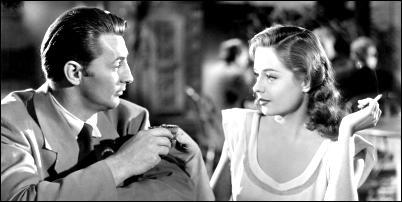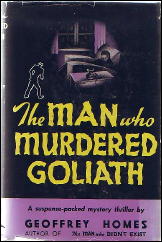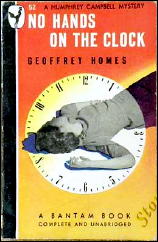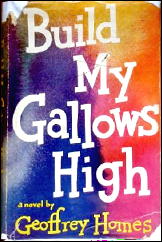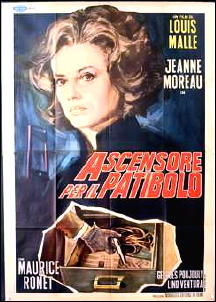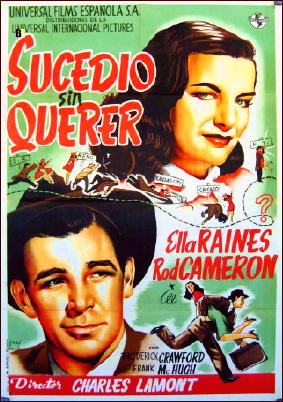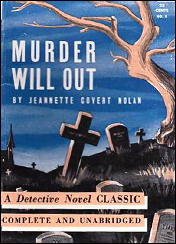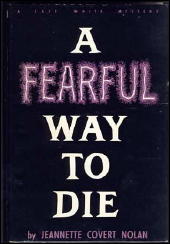February 2011
Monthly Archive
Mon 21 Feb 2011
A 1001 MIDNIGHTS Review
by Bill Pronzini
GEOFFREY HOMES – Build My Gallows High. William Morrow, hardcover, 1946. Paperback reprints include: Jonathan Press J35,digest, no date [1948]; Ace D-185, 1956, published dos-Ã -dos with The Humming Box, by Harry Whittington; Zebra “Movie Mystery Greats,” 1988.
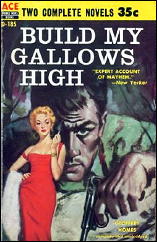
From 1936 to 1946, Geoffrey Homes (Daniel Mainwaring) published a dozen very good mysteries set primarily in the valleys and foothills of north-central California. Build My Gallows High is the last and best of the twelve, and so firmly established Mainwaring in Hollywood (he had been writing B movies since 1942) that he produced no more fiction during the last thirty-two years of his life.
This novel was filmed, from Mainwaring’s screenplay, as Out of the Past (1947), starring Robert Mitchum, Jane Greer, and Kirk Douglas — one of the half-dozen best noir crime films ever made.
Both novel and film are powerful studies of one man’s struggle to maintain the hope of his future when his jaded past catches up with him. Red Bailey is a former New York private detective, the kind “who first looked at a client’s supply of thousand-dollar bills, then at his social-and legal-status” before taking on a job; an angle player who made his big mistake when he went to work for a gambler named Whit Sterling.
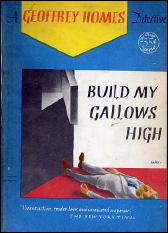
The job (told through flashback) was to find Sterling’s ex-mistress, Mumsie McGonigle, who shot and wounded Sterling and then ran off with $56,000 of his money. Red tracked Mumsie to Mexico, met and fell in love with her; and when she claimed she’d only shot Sterling in self-defense, Red stupidly double-crossed the gambler and helped Mumsie cover her tracks from Mexico to California.
But their relationship wasn’t what Red expected. When his former partner showed up at their country hideaway, murder drove the final wedge between them — and Red realized how badly he’d screwed up his life.
Determined to put Mumsie and the rest of it behind him, he made his way to a small town in the foothills of the Sierra Nevada, opened a gas station, and spent most of his free time fishing. He even met a new woman, one he learned to love more than Mumsie, one he planned to marry. Now, for the first time in his life, he is content.
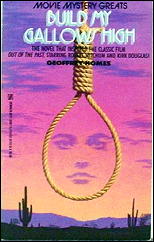
But then one day his past shows up in the person of a flashily dressed Greek gunman employed by Guy Parker, a crooked cop Red knew in the old days who now operates a gambling club in Reno. Red accompanies the Greek to see Parker, and finds that Mumsie is now Parker’s live-in girlfriend.
Parker wants Red to do a detective job for him; if he doesn’t agree, then Parker will tell Whit Sterling where to find him. Red smells a setup of some kind, with himself square in the middle, but what choice does he have except to do as Parker asks? Up to a point, that is …
This is a taut, hard-edged thriller, powerfully told in a clipped style reminiscent of Hemingway’s, with superb characterization and a hammer-blow climax. Anyone who has seen and admired Out of the Past will find Build My Gallows High every bit as memorable.
———
Reprinted with permission from 1001 Midnights, edited by Bill Pronzini & Marcia Muller and published by The Battered Silicon Dispatch Box, 2007. Copyright © 1986, 2007 by the Pronzini-Muller Family Trust.
Sun 20 Feb 2011
GEOFFREY HOMES – The Man Who Murdered Himself. William Morrow, hardcover, 1936. Avon, no number [#18], paperback, 1942.
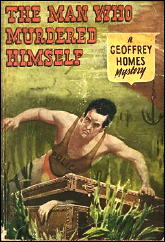
Working for a missing persons outfit specializing in lost heirs is a cutthroat business, at the fringe of legal niceties, requiring a stretch of the truth now and then, with a little money every so often into the right hands.
So we meet Robin Bailey, ex-newspaperman, on a case of either suicide or murder — death by personal pollution of a local reservoir.
Crackling dialogue and a twisting, turning plot, but short but effective glimpses of character and existence in the 1930 leave us wanting more in that regard, while Homes concentrates on the story. Bishop himself finds his work increasingly distasteful and begins to wonder why he never before noticed the office secretary.
The secondary characters, understated, unobtrusive, are even more memorable, exemplified by the sorrow displayed by the victim’s landlady. I believe this to be Homes’ first book. He’s worth looking into as a writer.
— From
Mystery*File #9, Vol. 2, No. 2, Spring 1976 (slightly revised).
Bibliographic Data:
The Robin Bishop series —
The Doctor Died at Dusk (n.) Morrow 1936.
The Man Who Murdered Himself (n.) Morrow 1936.
The Man Who Didn’t Exist (n.) Morrow 1937.
The Man Who Murdered Goliath (n.) Morrow 1938.
Then There Were Three (n.) Morrow 1938.
The latter is a crossover novel with the detective duties shared by Homes’ other major series character, PI Humphrey Campbell, who also works for the Morgan Missing Persons Bureau detective agency.
The Humphrey Campbell series —
Then There Were Three (n.) Morrow 1938.
No Hands on the Clock (n.) Morrow 1939.
Finders Keepers (n.) Morrow 1940.
Forty Whacks (n.) Morrow 1941.
Six Silver Handles (n.) Morrow 1944.
Homes also wrote two novels in which Mexican policeman Jose Manuel Madero was the primary detective:
The Street of the Crying Woman (n.) Morrow 1942.
The Hill of the Terrified Monk (n.) Morrow 1943.
and one standalone:
Build My Gallows High (n.) Morrow, 1946.
But if anything, either under his own name, Daniel Mainwaring, or as Geoffrey Homes, his list of credits is even longer on IMDB as a screenwriter.
Previously on this blog:
Forty Whacks. [A 1001 Midnights review by Bill Pronzini.]
Crime by Night, based on Forty Whacks. [A film review by Steve Lewis.]
Sun 20 Feb 2011
REVIEWED BY DAN STUMPF:
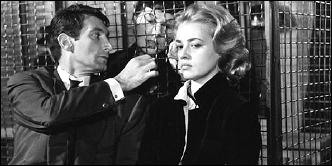
FRANTIC. Nouvelles Éditions de Films (NEF), 1958, as “Ascenseur pour l’échafaud.” Aka Elevator to the Gallows. Maurice Ronet, Jeanne Moreau, Georges Poujouly, Yori Bertin, Jean Wall. Based on the novel by Noël Calef (Paris, 1956). Director: Louis Malle.
Frantic is a typically French Crime Drama, filled with clever turns that kept me guessing right up to the end. Ronet is an ex-war hero, Moreau the wife of his wealthy bastard of a boss, and they’re so magnetic together I kept rooting for them to get away with that pre-doomed plot-hook of the genre, the “perfect murder.”
To tell anything at all about how their well-planned crime works out would be to spoil a genuinely ingenious piece of work. Indeed, watching it, I thought for a moment that the writer or director (or both) had taken leave of the story to pursue a hodge-podge of irrelevant detail — only to have everything tied together in a finish that left me gasping.
Sat 19 Feb 2011
REVIEWED BY GEOFF BRADLEY:
ABOVE SUSPICION: DEADLY INTENT. ITV, UK. January 3, 4 and 5, 2011. Kelly Reilly, Shaun Dingwall, Ciarán Hinds, Celyn Jones, Amanda Lawrence, Stine Stengade, Richard Brake. Screenwriters: Noel Farragher & Lynda La Plante, based on the latter’s novel. Director: Gillies MacKinnon.

This is the third in a series based on books by Lynda La Plante with Kelly Reilly as Anna Travis, a Detective Constable in the first two, but here for some reason bumped up to an impossibly young-looking Detective Inspector, and Ciarán Hinds as her rather grumpy boss, James Langton, now a Detective Superintendent.
In fact Langton says that his and Travis’s paths haven’t crossed since the previous case but here they are together again investigating the death of an ex-cop at a scene involving drugs. We know from the start that a high-powered drug dealer has had plastic surgery to change his appearance, but it’s how Travis gets on to the case despite put-downs from her colleagues that take up the bulk of the story (shown in three one hour, less adverts, instalments).
The whole thing is quite watchable but also quite risible in many respects both for Miss Reilly’s improbable dress sense as she investigates crimes in high heels and revealing tops, and the attraction here expressed, but not to each other, between the two leads.
Disappointing, too, for this blue-eyed optimist, was the rather downbeat ending. So, in summary, it’s not bad but flawed and not to be taken seriously for a moment.
Sat 19 Feb 2011

ROBERT TURNER – The Girl in the Cop’s Pocket. Ace Double D-177; paperback original; 1st printing, 1956. Published Published dos-Ã -dos with Violence Is Golden, by C. H. Thames (Stephen Marlowe).
When an old girl friend is accused of killing her wealthy husband with a method from one of his mystery yarns, ex-newspaperman Will Dennison heads back to the old mill town he grew up in. It’s a town on the way down; labor problems have forced the mills to head south. All that remain are the cheap hotels, the ramshackle homes of the unemployed, and cops who don’t care.
Dennison investigates and finds at the root a blonde who was forced to grow up too fast. (Why is the worst expected of the most beautiful?) The town is gross, but its inhabitants deserve it. So much for nostalgia!
Only a rather melodramatic finale brings the rating down. In The Girl in the Cop’s Pocket Turner tells a fast-paced tale.
Rating: C plus.
— From Mystery*File #9, Vol. 2, No. 2, Spring 1976 (slightly revised).
[UPDATE] 02-19-11. Robert Turner wrote a long list of stories for the detective pulps before they died out and he had to turn to paperbacks to continue writing. He has four novels in the Revised Crime Fiction IV under his own name, including this one, and one story collection.
As Don Romano he co-authored three of the five books in a Mafia series beginning with Operation Porno (1973), and ghosted two “Shaft” paperback originals under the name of the author who created the character, Ernest Tidyman.
On another note, I’ve always been fond of mystery novels in which the primary detective is the author of the same. Who was the first? How about the first one in which one of the author’s stories was used as the basis of a crime?
Sat 19 Feb 2011
REVIEWED BY STAN BURNS:
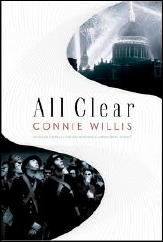
CONNIE WILLIS – All Clear. Spectra, hardcover, October 2010; trade paperback, October 2011.
This is the second book in Willis’ story of the British home front during WWII; the first was Blackout. Originally written as one big novel, because of the length it was split into two novels by the publisher.
Between the two of them they are over 1200 pages long — and that is the major problem. There is just too much happening — too many characters, too many events, too many disappointments. The combined novel should have been titled The Perils of Polly, who is the main character in a cast of thousands. She keeps flitting from one disaster to another, just like Pauline in the movie.
In this novel, set in the same time traveling universe as Willis’ award winning Doomsday Book, three historians from 100 years in the future are trapped in England during WWII. For some reason the time gates that let them go back home at the end of their studies will not open.
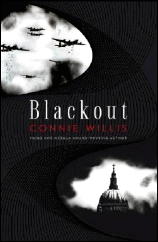
Ellen had been trapped in a mansion caring for children shipped out of London when an epidemic of measles broke out and she was quarantined and missed her pickup date. Polly worked as a shop girl in London during the Blitz. Matt had been badly wounded at Dunkirk. The three had finally found each other, compared notes, and resolved to find a way home at the end of the first novel.
And in this novel that’s what they try to do — for over 600 pages, futilely trying to find other historians, put messages in newspapers, and desperately try to get a message back to the future so they can be rescued over and over and over again, with completely futile results.
Isn’t the definition of insanity trying to do the same thing over and over again expecting a different result?
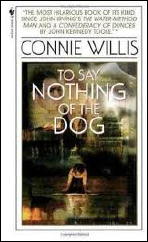
This whole thing, both novels together should not have been more than 400 pages long. At some point in writers’ careers, they lose the ability to edit themselves. It happened to Robert A. Heinlein in the 70s. It happened to David Weber seven or eight years ago. And now it has happened to Willis.
There is a lot of good stuff here — just too much of it. I found myself skip reading by the end of the first 200 pages. If you can manage to slog through it, this novel is worth reading, but be prepared to budget a lot of time doing it.
And let me also say here that I like Willis. To Say Nothing of the Dog is one of my favorite novels of the last ten years. I wish I had liked this one as much.
Rating: B minus.
Fri 18 Feb 2011
Posted by Steve under
Covers ,
ReviewsNo Comments
REVIEWED BY J. F. NORRIS:
ANN CARDWELL – Crazy to Kill. Mystery House, hardcover, 1941. Black Cat Detective #10, digest paperback, 1944. Harlequin #22, Canada, pb, 1949. Macfadden 35-119, paperback, 1962; Uni-Books reprint, no date. Nightwood Editions, softcover, Canada, 1990. The book was also converted to an opera with this title by James Reaney, Sr., and John Beckwith; it was performed in Canada in 1989.
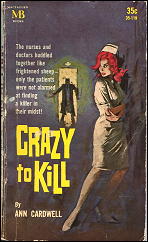
Earlier this month there was a post of a review of this book by Canadian author Ann Cardwell. The review by Bill Deeck ended with a tantalizing sentence trailing off in an ellipsis of ambiguity. “One of the rare mysteries with a mental institution setting and one of the rare… But that mustn’t be revealed.” We were all puzzled. What did Bill Deeck mean?
I ordered a copy and when it arrived last weekend read the very short novel rather quickly. The book, a paperback published by an outfit called Uni-Books, was littered with typos and punctuation errors but most infuriating of all the characters’ names kept changing — sometimes within the same paragraph. I don’t have any other copy to compare this with so I can’t tell where these errors came from, but it still drove me batty.
One of the murder victims is called Tim but he when he is first introduced his name changes from Tim to Tom in the span of one line. Later in the book he is referred to as Tom again and then Tim a few lines later. The narrator, Agatha Lawson, is once called Miss Lawrence which is the first name of one of the police detectives. Miss Lawson is also once called Miss Wilson — the name of one of the nurses in the hospital. On the rear cover of the book Dr. Holman is rechristened Dr. Holden by someone who clearly didn’t read the book.
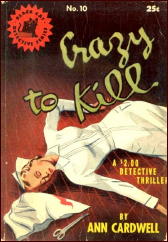
The blurb on the back also downplays the lurid murder story and instead focuses on a very minor incident involving a jealous lover’s triangle among two nurses and a doctor — although two doctor’s names are mentioned and a fourth nurse’s name is thrown into the works.
You can imagine how this was more than just a minor distraction like an occasional typo that may pop up in even a leading paperback publisher’s book. I even began to wonder if this was intentional. After all, Agatha Lawson is a mental patient and this could have been a clever manipulation of truth and delusion on the author’s part. Then I discarded that thought and did my best to overlook the errors and typos. The story was engaging enough and I ought not to let minutiae like that get the better of me
So to the story. Miss Lawson narrates a tale of a crazed murderer on the loose who is killing staff members and attacking patients seemingly at random. No motive seems clear. The multiple methods of murder (stabbing, bludgeoning, strangling) only reinforce the suspicion of a homicidal maniac at work.
I have to admit having been trained so well in the contemporary thriller trope of the “unreliable narrator” that I was skeptical of much of what Miss Lawson told the reader. I wasn’t sure I was getting the real facts and played closer attention to the other characters’ speeches and behavior.
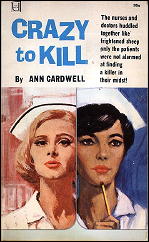
Agatha is also obsessed with leaving the institution and seems more concerned about passing her “sanity exam” than with the murderer in their midst. Yet somehow she is allowed to serve as a Watson to the two police detectives in charge of the investigation. As she tells Lt. Hogan, “It takes a thief to catch a thief,” implying that she knows more of the ways of the patients than an outsider would.
I hesitate to go into the sometimes complicated plot any further. Bill’s review does a good job of mentioning the salient points. Let me just say that Cardwell did a good job of misleading the reader. There are several surprises that caught me off guard leading up to the final revelation of the killer.
The final twist may not be a huge surprise but it was the perfect ending to a story that reminded me of a few of those British anthology horror films of the 1970s like Asylum and The House that Dripped Blood. Cardwell may well have created a minor classic in the subgenre of the homicidal killer mystery.
A review of other books published prior to 1941 might even prove that her book is a first of its kind. I cannot think of one earlier than this with a similarly constructed story although there are a handful with that rare … ah, but that must not be revealed. Deja vu, eh?
Editorial Comments: As far as I know, Uni-Books was one of those repackaging companies that bought up rights to books from other publishers and put new covers on them but more or less kept the text block the same. They then sold the books as the equivalent of instant remainders, dumping them off to drugstores and supermarkets to sell at whatever discount they chose.
The cover of the Macfadden edition, done by Ronnie Lesser, continued the “nurse” theme of the Black Cat version, but there’s still that menacing shadow standing in the doorway as a reminder that there is a mystery involved.
The Uni-Books cover, however, the lowermost of the three you see here is purely a generic one with nurses only. Unless you read the small print (the same as on the Macfadden), you’d never know it was a mystery. (Well, there is the title, of course.)
Thu 17 Feb 2011
Reviewed by DAVID L. VINEYARD:
THE RUNAROUND. Universal Pictures, 1946. Ella Raines, Rod Cameron, Broderick Crawford, Frank McHugh, George Cleveland, Joan Fulton, Samuel S. Hinds. Screenplay: Arthur T. Horman & Sam Hillman, based on a story by Arthur T. Horman & Walter Wise. Director: Charles Lamont.
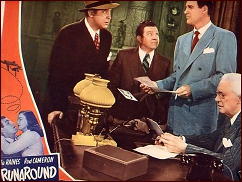
The Runaround is a mild screwball comedy in the vein of It Happened One Night, lifted above itself by the performances of Ella Raines, Rod Cameron, and Broderick Crawford, and solid direction from frequent Abbott and Costello director, Charles Lamont.
The plot might have come right out of the pulps or the slicks of the period. Cameron is Eddie Kildane, a private eye who has started his own agency with partner Wally Quayle (Frank McHugh) after one to many run-ins with Louis Prentice (Broderick Crawford), the unscrupulous manager of the Continental Detective Agency, their former boss.
Kildane quickly gets the upper hand, but Penelope is more than he counted on, and as he races across country with her, outwitting Prentice and dukeing it out with his men, the two unlikely love birds start to fall in love (to the recurring theme of “My Blue Heaven” sung and hummed by Cameron at first to annoy her and later by her to discomfort him, thanks to a canny Frank Skinner score).
The film follows the usual pattern of the runaway heiress theme with some hard-boiled hi-jinks thrown in, and while only mildly screwball, it still falls into the genre. Cameron and Raines seem to relish the chance to play comedy and their scenes together have real snap, so that it is a shame neither of them got more chances to make these kinds of films.
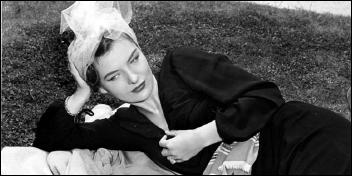
I don’t want to oversell this. It is not in the front rank of screwball comedy, but then it is better than many with better pedigrees (Love on the Run comes to mind). Cameron and Raines make an excellent team and the wisecracking script is both inventive and playful within both the screwball and private eye genres.
On top of that, there is a final twist in the tail that allows for a more realistic happy ending than usual and gives it a touch of the mystery, although no crime is involved, save a few laws Cameron and Crawford break in their double crossing rivalry,
The unusual cast makes the most of a chance to stretch and play outside their comfort zone. Raines is exceptionally attractive and appealing, Cameron charming and completely at ease, and Crawford ideally cast in the familiar role of a likable rat.
If you have missed it, and have a taste for screwball, romantic comedy, and screen private eyes this one will both surprise and delight you. Everyone in the film may get the runaround, but not the audience.
Thu 17 Feb 2011
THE BACKWARD REVIEWER
William F. Deeck
JEANNETTE COVERT NOLAN – “I Can’t Die Here.” Julian Messner, hardcover, 1945. Detective Novel Classic #49, digest paperback, no date [1946].
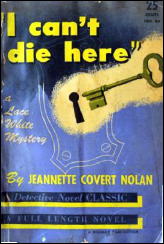
Described inaccurately as a “whilom” lieutenant of the State Police (Illinois?), Lace White is fifty, unmarried, and a writer of historical novels. In this novel, one of several featuring her, she is an obviously intelligent woman who nonetheless operates with no apparent police training and seemingly no common sense.
Though Dudley Shane, who has married into the rich Motley family in Capital City, has, or so we are told, a saint for a wife, Shane is a womanizer, without much staying power it would seem. Thus he has enemies, and thus he is shot one night and dies in his apartment, but not before one of his lovers has taken an overdose of amytal.
Called in as a special investigator, White detects well with people, not well with tangible evidence. Finding blood near the door of Shane’s office, she does nothing about it until the evidence is no longer needed. The murder weapon is a .38 Colt revolver, with, as you will no doubt not be surprised to hear, a working silencer, which White accepts unquestioningly.
Considering who the murderer is, the deceased’s actions — before he becomes deceased, of course — are inexplicable. The author portrays White, against type, as a foolish risk taker. Finally, the manifold awesome coincidences don’t help matters any.
— From The MYSTERY FANcier, Vol. 11, No. 4, Fall 1989.
Bio-Bibliographic Data: Bill guessed the locale of this novel to be Illinois, but Al Hubin in his Revised Crime Fiction IV, says it was Indiana, only one state to the right.
Here’s a list of all six Lace White books, as adapted from CFIV. These are author’s only works of crime fiction:
JEANNETTE COVERT NOLAN. 1897-1974.
Where Secrecy Begins (n.) Long 1938.
Profile in Gilt (n.) Funk 1941. [aka Murder Will Out, Detective Novel Classics #8, 1942]
Final Appearance (n.) Duell 1943.
“I Can’t Die Here†(n.) Messner 1945.
Sudden Squall (n.) Washburn 1955.
A Fearful Way to Die (n.) Washburn 1956.
Nolan’s papers were donated to the University of Southern Mississippi Library as part of their de Grummond Children’s Literature Collection.
Quoting from their website: “During her lifetime, Ms. Nolan wrote over forty-five children’s books including biographies, essays, and historical non-fiction. Although she wrote for both children and adults, she is most noted for her work in children’s literature. In 1961, she was awarded the Indiana Authors’ Day Award for Spy for the Confederacy. In 1968, Ms. Nolan was added to the Indiana University Writers Conference Hall of Fame. The next year she was named a Litterarum Doctor, an honorary doctor of letters and literature. She died on October 12, 1974.”
Thu 17 Feb 2011
Posted by Steve under
Reviews[3] Comments
A REVIEW BY RAY O’LEARY:
P. D. JAMES – The Murder Room. Alfred A. Knopf, US, hardcover, November 2003. Vintage, US, paperback, November 2004. UK edition: Faber & Faber, hardcover, 2003.
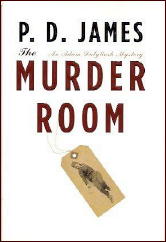
Commander Adam Dalgliesh meets a friend who convinces him to accompany him on a visit to the Dupayne Museum. This is a small place, seldom visited except by scholars, dedicated to the History of England between the two World Wars, and one of its rooms is devoted to famous murders between 1919 and 1938.
A week later Dalgliesh will be back when Dr. Neville Dupayne is burned to death in his car in the museum’s garage — a murder similar to one committed by Alfred Rouse in 1936.
Dr. Dupayne, his brother Sir Marcus, and their sister Caroline were the three trustees for the museum founded by their father. All three must agree on a lease renewal if the museum is to remain open. Neville had refused to do so and unless he changed his mind, or died, the museum would close. His siblings and the people who work there are thus supplied with motives for murder.
Normally, Dalgliesh and his unit would not be called in on this case but James Calder-Hale, the museum’s unpaid curator, happens to be a consultant to MI5, who are eager to having the case cleared up without that fact becoming known. Then, some days later, the body of a young woman is found in a trunk in the murder room — representing the murder of Violet McKee in the 1930’s who was also found in a trunk.
Basically, for all its 415 pages, this is a mystery novel Agatha Christie might have written if you exclude the sexcapade factor introduced towards the end, though Christie would have managed it in 200 fewer pages — not that the extra 200 pages aren’t well written and greatly enhance the character development, but they are essentially extraneous when it comes to the mystery element, which I figured out almost from the time the first murder was committed.
« Previous Page — Next Page »



